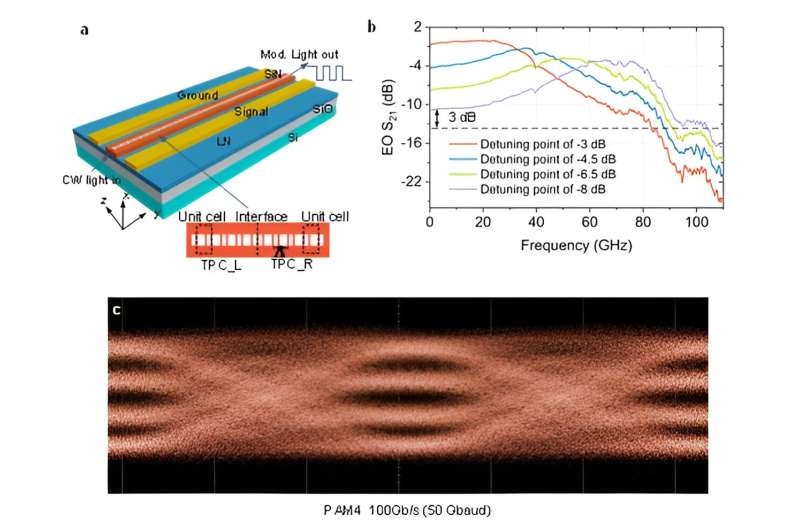This article has been reviewed according to Science X's editorial process and policies. Editors have highlighted the following attributes while ensuring the content's credibility:
fact-checked
peer-reviewed publication
trusted source
proofread
High-speed electro-optic modulation in topological interface states of a one-dimensional lattice

Electro-optic modulators, which convert signals from the electrical to the optical domain, are at the heart of optical communications, terahertz wireless communications, microwave signal processing, and quantum technology. Next-generation electro-optic modulators require high-density integration, compact footprints, large bandwidths, and low power consumption. They are challenging to achieve with established integrated Mach-Zehnder interferometer (MZI) or microring devices.
Attributing to the unique properties of topological photonics including tight optical confinement, robust transport of light, and immunity to defects, integrated lithium niobate (LN) waveguides with topological interface states can help address the challenges of next-generation electro-optic modulators.
Topological phase transition has been utilized to demonstrate integrated photonic devices including nonlinear and quantum devices, but the response times of the topological devices were limited to the microsecond order. High-speed topological modulators have not yet been exploited.
In a recent paper published in Light: Science & Applications, a team of scientists, led by Prof. Yikai Su and Prof. Yong Zhang from Shanghai Jiao Tong University and co-authors have developed an ultracompact, high-speed, large-bandwidth, and energy-efficient electro-optic modulator with a topological interface state in a 1D microstructure lattice on a silicon-nitride-loaded-lithium-niobate-on-insulator (SiN-LN) platform. The 1D topological cavity features a shorter length than the conventional 1D Bragg grating structures.
Unlike the photonic crystal nanobeam cavity with multiple resonant modes, the topological cavity allows flexible control of the Q factor and mode volume while strictly maintaining single-mode operation and avoiding the mode number control. Experimental results show that the length of the high-speed electro-optic modulator is only 140 μm, with an ultralow power consumption of 5.4 fJ/bit and a large modulation bandwidth of 104 GHz.
The topological modulator is based on topological interface state, which is formed between two topological photonic crystals with distinct topological invariants and surface impedance in the 1D lattice based on the classic Su-Schrieffer-Heeger (SSH) model. To obtain a topological interface state at one photonic bandgap, the gap topological invariants on the left and right topological photonic crystals are required to ensure a difference of π.
A method of crossing a topological transition point is used to change the sign of the topological invariant. The device exhibits excellent performance in terms of ultrasmall size, high speed, and energy efficiency. These scientists summarize the operational principle of their topological modulator:
"The interface state enables the first topological modulator with a compact size of only 1.6 × 140 μm2, which is the most compact thin film LN modulator with a bandwidth exceeding 20 GHz. Peaking enhancement in the electro-optic response of the topological cavity is utilized to break the photon-lifetime-limited bandwidth, resulting in a large bandwidth of 104 GHz."
"Due to the small electro-optic modal volume and short electrode length, low radio frequency loss and small capacitance are achieved, yielding ultralow energy consumption of 5.4 fJ/bit." They added.
"The demonstrated devices can generate 100 Gb/s non-return-to-zero (NRZ) and 100 Gb/s four-level pulse amplitude modulation (PAM4) signals. To the best of our knowledge, we have implemented the first high-speed topological electro-optic modulator using the topological interface state. The topological modulator shows great promise for applications of high-speed modulation in fully integrated LN photonics and promotes applications of topological devices in optical communications, microwave photonics, and quantum information processing," The authors said.
More information: Yong Zhang et al, High-speed electro-optic modulation in topological interface states of a one-dimensional lattice, Light: Science & Applications (2023). DOI: 10.1038/s41377-023-01251-x
Journal information: Light: Science & Applications
Provided by Chinese Academy of Sciences





















